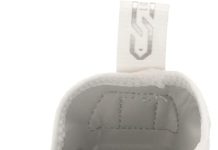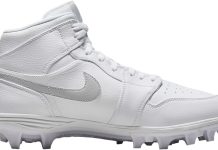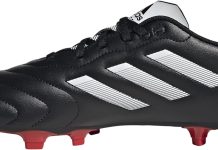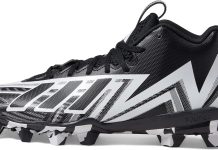In the world of sports, the choice between detachable and molded cleats has always been a subject of debate. On one hand, detachable cleats offer versatility and customization, allowing athletes to adapt to different playing conditions. On the other hand, molded cleats provide stability and durability, ensuring a consistent performance on various surfaces. With both options having their own advantages and disadvantages, it is crucial for athletes to understand the pros and cons of detachable versus molded cleats.
Durability
Detachable Cleats: Detachable cleats are known for their durability. The ability to remove and replace the cleats allows for easier maintenance and replacement, which helps prolong the lifespan of the shoe. If a cleat gets damaged or worn down, it can simply be replaced without needing to purchase a whole new pair of shoes.
Molded Cleats: Molded cleats, on the other hand, are also durable but lack the versatility of detachable cleats. Once the cleats wear down or get damaged, the entire shoe needs to be replaced. This can be costly and inconvenient, especially if the shoes are still in good condition except for the cleats.
Performance
Detachable Cleats: When it comes to performance, detachable cleats offer an advantage. The ability to customize the type and length of the cleats depending on the field conditions gives players better traction and control. This adaptability allows for optimal performance in different playing surfaces and weather conditions.
Molded Cleats: Molded cleats, on the other hand, have a fixed design that may not be suitable for all field conditions. While they may perform well on certain surfaces, they can be less effective on wet or muddy fields. The lack of adaptability can limit a player’s performance in certain situations.
Versatility
Detachable Cleats: One of the major advantages of detachable cleats is their versatility. By being able to switch out the cleats, players can use the same pair of shoes for different sporting activities. Whether it’s playing soccer, football, or baseball, detachable cleats can be adapted to the specific requirements of each sport.
Molded Cleats: Molded cleats, on the other hand, are designed for a specific sport and field conditions. Their fixed design limits their versatility and makes them less suitable for other sports. If a player participates in multiple sports, they would need to invest in separate pairs of shoes.
Comfort
Detachable Cleats: Detachable cleats offer the advantage of adjustability, allowing players to find a comfortable fit. They can adjust the length and type of cleats to suit their playing style and personal preferences. This customization can help prevent discomfort and reduce the risk of blisters or injuries.
Molded Cleats: Molded cleats are generally comfortable due to their cushioning and support. However, since they have a fixed design, they may not be as comfortable for players with specific foot conditions or preferences. Some players may find that molded cleats don’t provide the same level of comfort and support as detachable cleats.
Traction
Detachable Cleats: Detachable cleats excel in providing superior traction. With the ability to switch out different cleat lengths and designs, players can optimize their traction on various field conditions. Whether it’s longer cleats for wet grass or shorter ones for artificial turf, detachable cleats offer better grip and stability, enhancing a player’s performance and reducing the risk of slipping.
Molded Cleats: Molded cleats also provide decent traction, but they may not be as effective on certain field conditions. Their fixed design limits their adaptability, and they may struggle to provide optimal grip on wet or slippery surfaces. This can compromise a player’s performance and increase the risk of injury.
Maintenance
Detachable Cleats: Detachable cleats are relatively easy to maintain. If a cleat gets damaged or worn down, it can be quickly replaced without having to buy a whole new pair of shoes. This not only saves money but also extends the lifespan of the shoes. Regular cleaning and inspection of the cleats ensure that they remain in good condition for longer.
Molded Cleats: Molded cleats require less maintenance since they don’t have detachable parts. However, if the cleats wear down or get damaged, the entire shoe needs to be replaced. This can be more expensive and inconvenient, especially if the rest of the shoe is still in good condition.
Cost
Detachable Cleats: Detachable cleats tend to have a higher upfront cost compared to molded cleats. This is due to the added technology and options for customization. However, in the long run, detachable cleats can be more cost-effective since only the cleats need to be replaced when they wear down or get damaged, instead of buying a whole new pair of shoes.
Molded Cleats: Molded cleats are generally more affordable upfront, making them a popular choice for budget-conscious players. However, if the cleats wear down or get damaged, the entire shoe needs to be replaced, which can be more expensive in the long run.
Field Conditions
Detachable Cleats: Detachable cleats are highly adaptable and can be customized to suit various field conditions. Whether it’s a muddy field, wet grass, or artificial turf, players can adjust the length and type of cleats to optimize their performance. This adaptability gives an advantage in unpredictable weather and playing surfaces.
Molded Cleats: Molded cleats are designed with a specific type of playing surface in mind. While they may perform well on the recommended surface, they can be less effective on other field conditions. This lack of adaptability can be a disadvantage in changing weather or playing on different surfaces.
Injury Risk
Detachable Cleats: Detachable cleats can help reduce the risk of injuries. By allowing players to customize the length and type of cleats, players can optimize their grip and stability. This reduces the chances of slipping, sliding, or sudden directional changes that can lead to ankle sprains or other injuries.
Molded Cleats: Molded cleats provide a decent level of support and stability, which can help reduce the risk of injuries. However, their fixed design may not provide the same level of customization and adaptability as detachable cleats, increasing the chances of slipping or getting caught on uneven surfaces.
Rulebook Compliance
Detachable Cleats: Detachable cleats are compliant with most sports rulebooks since they can be adjusted to meet the specified cleat requirements. This versatility allows players to use the same pair of shoes for different sports and ensures they meet the regulations for each sport they participate in.
Molded Cleats: Molded cleats are designed according to the regulations of specific sports. While they may be compliant with those particular rules, they may not be suitable for other sports that have different cleat requirements. Players would need to purchase separate pairs of shoes to comply with different sports’ rulebooks.
In conclusion, the choice between detachable and molded cleats largely depends on personal preferences, budget, and the specific needs of the player. Detachable cleats offer durability, performance, versatility, comfort, traction, easy maintenance, adaptability to field conditions, lower injury risks, and rulebook compliance. On the other hand, molded cleats are more affordable upfront but may lack in some of these aspects, particularly customization and versatility. Players should carefully consider their playing style, the field conditions they frequently encounter, and their budget before deciding on the type of cleats to invest in.





































